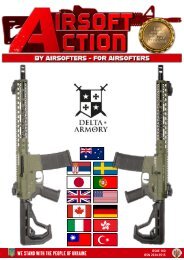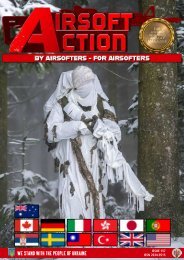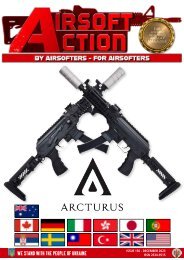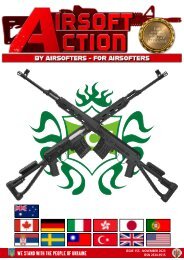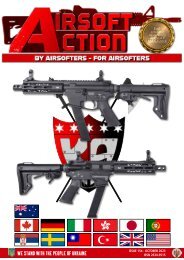PMCI - September 2021
It's been another hard slog for the PMCI crew this time, as curbs on international travel continue to curb our ability to actually get together but as usual, Bill and Trampas have pulled yet another great issue out of the (drag!) bag - and it's a very special one that headlines with a "Dream Rifle Build" that replicates the iconic Ruger Mini 14 as used by "Hannibal and the Team"... We do love it when a plan comes together! We're also joined again by Jim W, who brings a deep-dive insight into the world of profiling and we look in detail at what some of our favourite manufacturers have been up to, landing our test reports in full! All in all, it may have taken just a bit more time, and some serious "logistics juggling" to get this issue together but we hope you'll agree it's been worth the wait!
It's been another hard slog for the PMCI crew this time, as curbs on international travel continue to curb our ability to actually get together but as usual, Bill and Trampas have pulled yet another great issue out of the (drag!) bag - and it's a very special one that headlines with a "Dream Rifle Build" that replicates the iconic Ruger Mini 14 as used by "Hannibal and the Team"... We do love it when a plan comes together!
We're also joined again by Jim W, who brings a deep-dive insight into the world of profiling and we look in detail at what some of our favourite manufacturers have been up to, landing our test reports in full!
All in all, it may have taken just a bit more time, and some serious "logistics juggling" to get this issue together but we hope you'll agree it's been worth the wait!
- No tags were found...
You also want an ePaper? Increase the reach of your titles
YUMPU automatically turns print PDFs into web optimized ePapers that Google loves.
pmcimagazine.com
PROFILING
JIM: Sure thing Trampas, let’s start with a definition.
• Blindspots: Are a lack of insight or awareness—often
persistent—about a specific area of one’s behavior or
personality, typically because recognizing one’s true feelings
and motives would be painful. E.g., Within a security setting,
there can be certain types of individuals who attribute
aggression to others, when in reality, they are aggressive,
AKA “shit magnets.”
• Bias blind spots: People tend to see themselves as less
susceptible to influence and persuasion than others. E.g., “It
was my idea to go on the offensive” (when in reality the
individual had been triggered to go on the offensive through
being set up to do so). This particular blind spot tends to be
driven by a fear of humiliation, (more on this later).
• Situational blindspots: When we have seen what we
have seen so often, we become less likely to observe
changes. E.g., Complacency caused by the individual’s lack of
awareness/ attention to detail (which we attribute to blind
spot development)
PMCI: Can you provide us with an example of how you have
eliminated blind spots?
Jim: I’ll try to give a brief example; depending on the role,
situation, and environment, our rules of engagement will
change, and thus our responses will vary; however, the
system does not. We are all familiar with Boyd’s OODA loop;
it’s part of our training. I utilized over the years to study
humans and working in the field to apply OODA to physical
and conversation engagements. For instance, I’m talking with
a subject at a checkpoint. As I am talking to them, I conduct
a scan starting from the hands to the feet then back up to
the head while simultaneously listening to what is or isn’t
being said. As I do this, I assess whether or not this person
is a threat to me, so I am looking for pre-assault indicators
while listening to tonality and word choice. OODA comes in
because I will take some small steps either side to side or
backward while this is going. In doing this, you will see the
level of focus the subject has on you. If they are focused on
you, you will see them re-orient and move toward you. I do
this a couple of times as I watch for non-verbal and verbal
cues. Once I see at a minimum of three cues, I can then be
proactive in my approach to either using communication to
diffuse the situation or take proactive physical action to gain
and keep control of the situation. In this business, action beats
reaction and we strive to give those we train an advantage
in the field. Each time we move and make the subject reorient,
we are simply buying ourselves some time to assess
the encounter and act accordingly.
This approach works conversationally as well, as we
can re-orient someone while conversing by using a similar
approach.
We adjust posture, use head and hand movements, subtle
things that allow us to interject in the conversation and
diffuse or move the conversation to a topic we wish to speak on.
When we showed experienced field operatives with
10,000 plus hours of experience a systematic approach
to reading non-verbal behavior, they told us… “yes, I can
recognize around 80% of what you’ve shown me - the big
difference being that you’re using a systematic approach, so
it’s a much more efficient, effective, and adaptive approach”.
Here is the issue, if the approach to interpreting nonverbal
behavior is not standardized, success/ failure can’t be
measured and managed to ensure ongoing improvements/
vulnerability reduction. Furthermore, the vets understand
that in support of novice and intermediate operatives, a
systematic approach helps maintain a level of situational
awareness on a team rather than a leadership level.
PMCI: Here’s my issue Jim, doesn’t learning to read and
analyze behavior on a professional level correctly require
serious amounts of training?
Jim: With respect, if the training provided is role, situation,
and objective specific… We will typically process a security
team to mission/ objective readiness with no fluff training in
around 12-16 hours.
From a management perspective: Recording the training
and nominating an internal trainer (post-delivery) provides
incoming operatives with around 3 hours of video-based
learning - with practical in-person training delivered according
to the requirements of the Team’s nominated trainer.
We find this approach transformational as incident
reporting includes a much higher standard of observation…
when shared; these observational notes provide better levels
of pre-emptive awareness… all of which contribute to a
Preemptive Evaluation & Comms. Playbook.
For an example of the playbook in action, you can get
a (non-self-promotional) case study packed with applicable
insights by emailing jim@procypher.co
If you like what you see: You are also welcome to a Live
& Online breakdown of the case study. The aim is to provide
you with a systematic “how to” approach to interpreting nonverbal
behavior.
PMCI: Okay, Jim, the last topic... when you say “words are
weapons”... what do you mean?
Jim: We have all worked with a shit magnet… someone who
could start a fight in an empty room, and we’ve all worked
with a person who beats the opponent by turning them into
an ally…
PMCI: What would you say is the key difference between the
two?
Jim: It’s not always possible to control the conversation
from the get-go; furthermore, controlling conversations/
12







